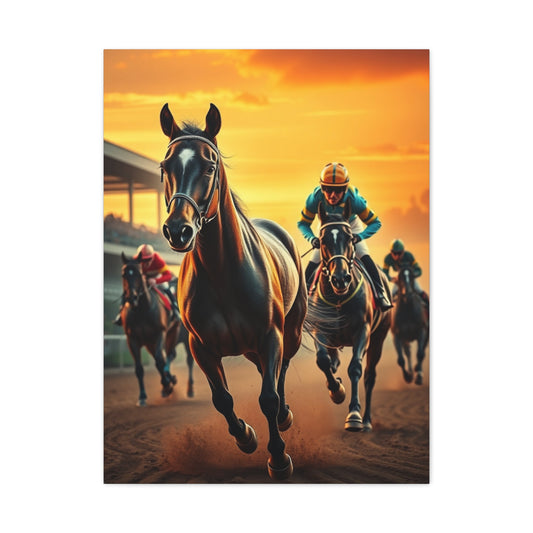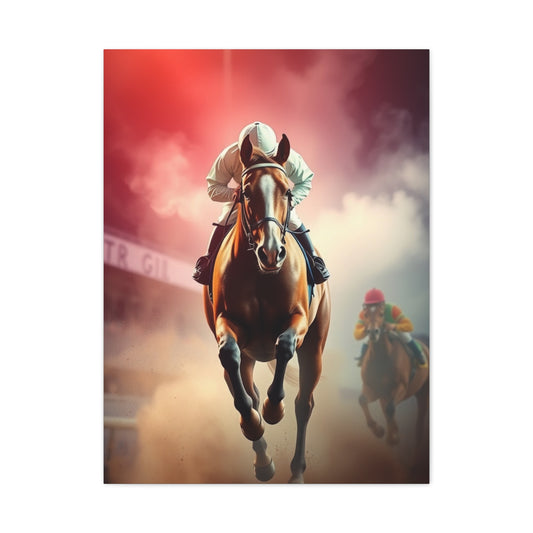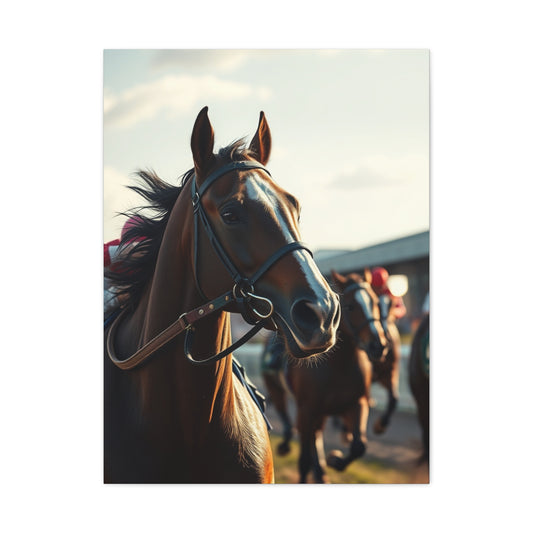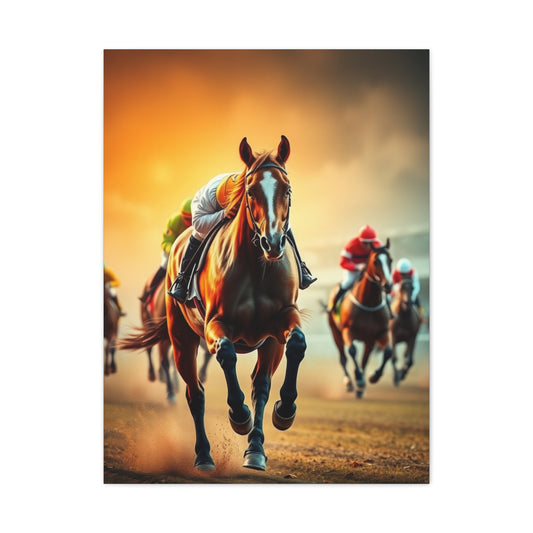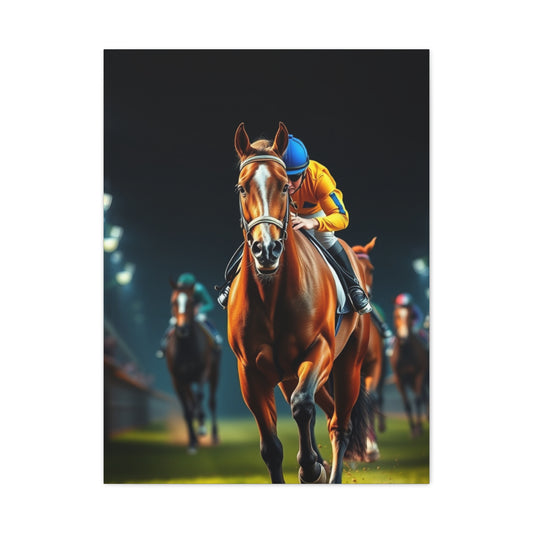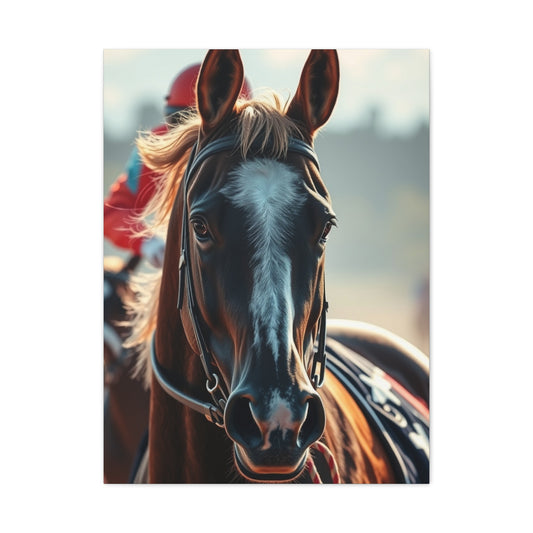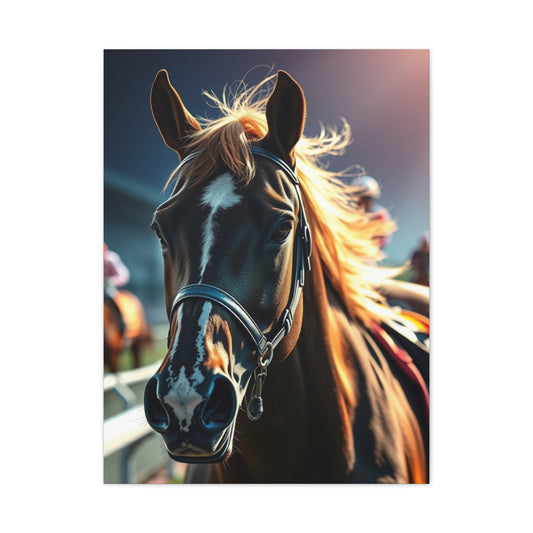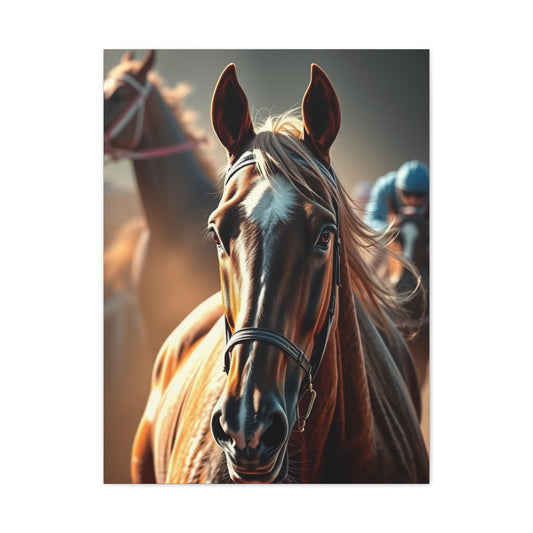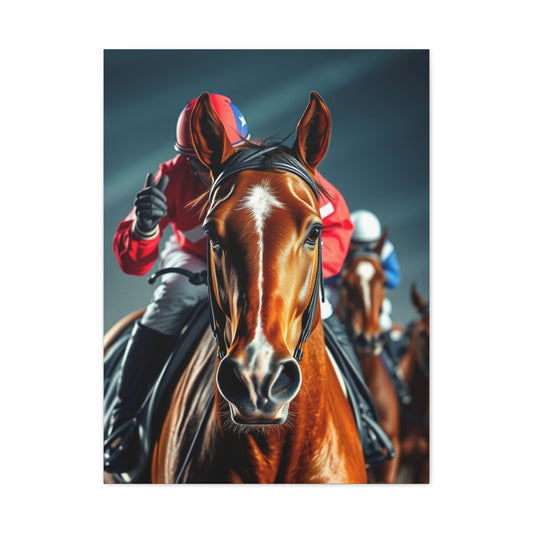Horse Racing Wall Art That Brings Elegance and Personality to Any Room
Throughout history, horses have embodied grace, power, and loyalty, making them one of humanity’s most enduring companions. From ancient cave paintings to intricate Renaissance tapestries, the image of the horse has been celebrated across cultures as a symbol of strength, freedom, and majesty. In the world of interior design, this fascination translates seamlessly into wall décor, where equestrian imagery enriches living spaces with both elegance and personality.
Horse wall decorations hold a distinctive place in design because they connect us to a timeless bond between humans and animals. When incorporated thoughtfully, they provide more than surface-level beauty; they evoke nostalgia, passion, and the spirit of open landscapes. Whether used in rustic cabins, countryside cottages, or modern urban lofts, horse-inspired interiors have the versatility to adapt across themes without losing their symbolic depth.
Exploring the Versatility of Horse Wall Décor
Horse wall décor is not confined to one aesthetic style. Its adaptability allows it to complement numerous atmospheres, from rugged and rustic to sleek and contemporary. This flexibility stems from the horse’s universal imagery—its lines, forms, and movement resonate across artistic mediums.
A country farmhouse might embrace wooden silhouettes and handcrafted carvings, while a modern penthouse could lean toward abstract equestrian wall art rendered in metal or glass. By selecting the right medium, texture, and arrangement, homeowners can weave equestrian motifs into interiors that reflect their unique sensibilities. The rare ability of horse art to cross stylistic boundaries makes it a cornerstone for those seeking to blend tradition with innovation.
The Language of Materials in Horse-Themed Art
The materials used in horse wall decorations are not merely functional; they shape the tone and narrative of a space. Wood conveys warmth, tradition, and a rustic sensibility. Its natural grains and imperfections enhance equestrian motifs, creating a tactile connection to the organic world. In contrast, metal sculptures carry a sense of permanence and resilience, echoing the muscular strength of horses while lending an industrial elegance to interiors.
Canvas paintings provide visual storytelling, whether realistic depictions or imaginative abstractions. Photography, particularly black-and-white equestrian images, introduces sophistication and timelessness, capturing fleeting moments of equine spirit frozen in time. Textile art, from woven tapestries to embroidered hangings, adds depth and dimension, inviting touch as much as sight. The careful choice of material is integral in shaping how horse décor resonates with the viewer.
Rustic Charm through Horse Wall Art
Rustic horse decorations remain a perennial favorite because they capture the essence of simplicity and authenticity. Rustic design emphasizes natural elements, aged textures, and earthy palettes, making it the perfect backdrop for equestrian imagery. Wooden plaques engraved with horse silhouettes, distressed signs bearing equestrian quotes, or handcrafted tack all harmonize beautifully within rustic interiors.
The rustic aesthetic values imperfection and patina, seeing beauty in weathered surfaces and organic irregularities. In this sense, rustic horse wall décor celebrates the raw and unrefined qualities of both nature and craftsmanship. It transforms walls into stories of heritage and passion, drawing inspiration from barns, stables, and wide-open fields. For those who wish to anchor their living spaces in nostalgia and rural charm, rustic horse art offers a deeply satisfying path.
Modern Interpretations of Horse Wall Décor
While rustic motifs remain popular, modern interpretations of horse wall art are equally compelling. Contemporary design often leans toward minimalism, clean lines, and abstract forms. Within this framework, horses can be represented in bold, unconventional ways—geometric patterns, silhouette cut-outs, or metallic outlines that reduce the animal’s form to its essential movement.
Modern horse wall decorations excel in creating striking focal points. A large monochromatic canvas depicting a horse in motion can dominate a living room, while a series of sleek metal panels can provide a sense of rhythm and dynamism along a hallway. The emphasis lies in using equestrian imagery not as ornament but as a defining architectural element of the space. This approach elevates horse art beyond mere decoration into the realm of interior identity.
Arranging Horse Wall Decorations with Intention
The placement of horse-inspired art is as crucial as the pieces themselves. A well-chosen arrangement can shift the entire atmosphere of a room. Gallery walls, for instance, allow for eclectic storytelling by combining diverse equestrian pieces—photographs, sketches, signs, and artifacts—into a cohesive narrative. The interplay of varying frames, sizes, and textures adds rhythm and depth to otherwise plain walls.
For those who prefer simplicity, a single large statement piece can anchor a room, drawing the eye and establishing focus. This works especially well in modern interiors where restraint and clarity define the aesthetic. Consistency of theme and color palette across decorations ensures harmony, preventing visual clutter while maintaining dynamism. Thoughtful placement transforms equestrian wall art from decoration into an integral component of spatial composition.
The Allure of Handmade Equestrian Pieces
Handmade horse wall décor offers a level of uniqueness that mass-produced items cannot match. Crafted with care, these pieces carry the imprint of their maker, reflecting individuality and authenticity. Whether a woodcarving by a local artisan or a hand-painted canvas created at home, handmade décor pieces become personal treasures.
They also offer a chance to experiment with rare techniques and unusual materials. Pyrography on reclaimed wood, metal embossing, or handwoven tapestries depicting equestrian motifs infuse interiors with originality. Handmade horse art embodies the principle that decoration is not merely visual but experiential—a dialogue between maker, subject, and observer.
The Role of Color in Horse-Inspired Interiors
Color profoundly influences how horse wall art interacts with a room. Neutral tones such as beige, cream, and taupe create serene backdrops that allow equestrian imagery to stand out with understated elegance. Earthy palettes—browns, greens, and terracotta—resonate naturally with rustic horse decorations, reinforcing their organic roots.
For bolder interpretations, deep blues, rich reds, or metallic accents can elevate modern equestrian wall art into dramatic statements. Black-and-white compositions, on the other hand, offer timelessness and sophistication, often suitable for minimalist or industrial interiors. The interplay between color and imagery can either harmonize with the existing décor or deliberately contrast it to provoke visual intrigue.
Horse Tack as Decorative Art
Beyond paintings and sculptures, horse tack itself can serve as powerful decorative art. Saddles, bridles, reins, or horseshoes, when mounted thoughtfully, bring authenticity and tactile richness to interiors. Vintage tack, in particular, carries stories of past use, transforming into heirlooms displayed proudly on walls.
This approach bridges function and aesthetics, blurring the line between utility and ornament. Horse tack displays are especially effective in rustic or eclectic interiors, where authenticity and narrative depth are valued. By showcasing these objects, homeowners create living museums that honor equestrian heritage while enriching their walls with texture and history.
Cultural Symbolism in Horse Décor
Different cultures have interpreted the symbolism of horses in varied ways, and this richness deepens the meaning of equestrian wall art. In many traditions, horses represent victory, freedom, and journey. In Asian art, they often symbolize perseverance and speed, while in European traditions, they embody nobility and conquest. By incorporating horse imagery, homeowners unconsciously invite these layers of symbolism into their spaces.
This cultural depth makes horse décor more than visual ornamentation; it becomes a medium through which universal archetypes and personal interpretations coexist. The result is an environment enriched not only by beauty but by stories and values interwoven through history.
Crafting Atmosphere through Horse Wall Decorations
Ultimately, horse wall décor is about crafting atmosphere. It transforms blank surfaces into evocative canvases, shaping how spaces are experienced. Rustic horse decorations cultivate warmth, intimacy, and nostalgia. Modern equestrian art fosters boldness, clarity, and sophistication. Handmade and personal pieces create intimacy, while large-scale imagery fosters grandeur.
By carefully curating horse-inspired interiors, one can construct environments that reflect not only stylistic preferences but also personal identity and emotional resonance. The versatility, symbolism, and beauty of horses ensure that their imagery remains a timeless source of inspiration in interior design.
The Multifaceted Nature of Horse-Inspired Design
Horse wall décor thrives because it can embody an incredible range of stylistic directions. Some pieces convey rustic authenticity, others lean toward sophisticated minimalism, while still others embrace eclectic layering. This versatility is what allows equestrian motifs to adapt seamlessly to vastly different interiors. A single horse silhouette may feel entirely different depending on its material, scale, and arrangement. Understanding the stylistic breadth of horse wall art is essential for anyone looking to integrate it into their environment with intention.
The Rustic Aesthetic and Its Relationship with Horses
Rustic interiors emphasize authenticity, warmth, and natural materials. Within this aesthetic, horse decorations feel at home, as the connection between horses and the countryside runs deep. Weathered wood plaques, vintage stable signs, and carved equestrian figures bring both history and texture to rustic environments. The imperfections—cracks in wood, fading paint, or worn edges—are not flaws but hallmarks of character, echoing the rawness of life outdoors.
Rustic horse décor pairs harmoniously with stone fireplaces, exposed beams, and leather furnishings. Together, these elements evoke stables, barns, and pastoral landscapes. In such spaces, the presence of horses on the wall is not ornamental but almost inevitable, a natural continuation of the rustic ethos itself.
Modernist Interpretations of Horse Imagery
In stark contrast to rustic sensibilities, modern interiors demand precision, clarity, and a refined balance between form and function. Here, horse wall décor shifts from textured authenticity to clean-lined abstraction. Minimalist black silhouettes, stylized geometric forms, or sleek metallic sculptures transform equestrian imagery into something streamlined and contemporary.
A single oversized canvas featuring a monochromatic horse portrait can define an entire living room. Metal panels shaped into abstract equine figures introduce depth without overwhelming simplicity. These modern interpretations strip away extraneous detail, reducing horses to their essence of motion, strength, and symmetry. They prove that equestrian motifs can feel as progressive as they are traditional.
Industrial Spaces and the Boldness of Metal
Industrial interiors, often defined by raw materials such as steel, brick, and concrete, provide another compelling stage for horse wall art. In these settings, metal sculptures and installations take precedence. Welded silhouettes or hammered reliefs capture the muscular energy of horses while reflecting the toughness of industrial surroundings.
A life-sized cut-out in brushed steel or rusted iron, mounted against an exposed brick wall, becomes an arresting focal point. Unlike rustic wood or delicate paintings, industrial horse art revels in strength and permanence. Its boldness resonates with lofts, warehouses, and modern workspaces that demand statement pieces capable of holding their ground against robust architectural features.
The Elegance of Classical and Traditional Décor
Traditional interiors, often characterized by symmetry, ornate furnishings, and layered textures, embrace equestrian wall décor differently. Classical horse paintings, framed in gilded wood or ornate gold leaf, resonate with these spaces. Depictions of horses in historical attire or pastoral landscapes evoke nobility and grandeur.
Equestrian portraits in oil, engravings from past centuries, or large woven tapestries depicting hunting or riding scenes provide an atmosphere of refinement. In traditional settings, horse art functions as a nod to heritage and lineage, suggesting continuity between the past and present. The animal’s enduring symbolism—nobility, grace, and loyalty—feels entirely at home within spaces steeped in tradition.
Eclectic Approaches to Equestrian Wall Art
For those who resist adherence to a single aesthetic, eclectic design offers freedom to blend rustic, modern, classical, and even whimsical interpretations of horse imagery. A gallery wall might combine a vintage sepia photograph with a vibrant abstract painting. A carved wooden horse head could hang beside a glossy digital print.
Eclectic arrangements thrive on tension and contrast. The key is not uniformity but balance—curating a mix that feels intentional rather than chaotic. Horse wall décor in eclectic spaces becomes part of a larger mosaic, where its diversity of forms enriches rather than fragments the room’s personality.
The Role of Scale in Horse Decorations
Size plays a critical role in how horse-inspired art impacts a space. A small bronze relief hung discreetly in a hallway invites intimacy, while a towering canvas of galloping horses across a living room wall commands immediate attention. Scale dictates not just visibility but atmosphere.
Large-scale pieces often serve as focal points, demanding space and quiet around them to breathe. Smaller works function best as details, punctuating spaces without overwhelming them. Groupings of smaller pieces can collectively generate an impact equal to that of a single monumental artwork, while still preserving variety. Choosing the right scale ensures that horse wall décor integrates seamlessly into its environment without feeling either underwhelming or overpowering.
Textures and Tactility in Horse Wall Décor
Beyond imagery, the texture of horse art influences how it is experienced. Smooth canvases evoke calm and refinement, while rough-hewn wooden plaques bring rawness and earthiness. Three-dimensional sculptures, reliefs, or tapestries invite tactile engagement, tempting viewers to reach out and feel their surfaces.
Texture also plays a key role in layering. A distressed wooden horse silhouette set against a polished plaster wall generates dynamic contrast. A glossy black-and-white photograph placed alongside a coarse woven textile introduces interplay between sleekness and roughness. This tactile dialogue enhances depth and keeps equestrian wall décor visually and physically engaging.
Personalized Horse Art as a Design Statement
Personalized equestrian art adds another dimension to interiors. Custom portraits of beloved horses, rendered in oil, watercolor, or digital mediums, transform walls into personal sanctuaries. Unlike generic imagery, these works resonate with identity and memory.
Even subtle personalization—engraving a family name alongside a horse silhouette on wood, or incorporating specific tack into wall-mounted displays—infuses décor with individuality. Personalized horse art bridges the gap between decoration and autobiography. It does not simply occupy space but tells a personal narrative woven into the broader design.
Regional and Cultural Interpretations of Horse Imagery
Equestrian wall décor is also shaped by regional traditions. Southwestern interiors often feature horses within desert landscapes, rendered in warm, earthy tones. In contrast, Scandinavian design may embrace minimalist silhouettes, pared down to black lines against white walls.
Cultural symbolism adds layers of meaning as well. In Middle Eastern art, horses are associated with honor and pride, while in East Asian depictions, they often symbolize diligence and endurance. Incorporating horse wall art with cultural awareness enriches its significance, transforming it into more than decoration—it becomes a bridge between space, identity, and heritage.
Symbolic Resonance within Contemporary Spaces
Even in highly modern environments, the symbolic depth of equestrian art cannot be ignored. Horses continue to embody freedom, vitality, and harmony with nature. When mounted on the walls of sleek apartments or offices, they remind inhabitants of values often neglected in fast-paced urban life.
An abstract steel outline of a horse might appear purely aesthetic at first glance, but beneath its minimalism lies centuries of association with endurance and spirit. This duality—visual appeal paired with symbolic richness—ensures that horse wall décor remains powerful even within contexts far removed from stables or countryside landscapes.
Blending Indoor and Outdoor Narratives
Another strength of horse wall décor lies in its ability to blur the boundaries between indoor and outdoor life. A mural of galloping horses across an accent wall can evoke wide fields and open skies within the confines of an urban apartment. Wooden carvings, rustic signs, or photographic landscapes allow homeowners to carry the essence of the outdoors into their private interiors.
This blending creates continuity between natural and built environments. For those who crave the freedom of open spaces but live within structured urban architecture, horse wall art serves as a bridge—a reminder of landscapes, journeys, and the primal bond between humanity and animals.
Transforming Transitional Spaces with Horse Décor
Hallways, entryways, and staircases often serve as neglected canvases in interior design. Yet these transitional spaces are ripe for transformation through horse wall décor. A row of framed equestrian sketches lining a corridor turns an otherwise utilitarian passage into a gallery. A single horse relief above a doorway greets guests with symbolic energy upon arrival.
These placements underscore the idea that horse art is not confined to central living spaces. It can enrich every corner of a home, from bedrooms to offices, from private nooks to shared corridors. Wherever walls exist, they can become carriers of equestrian imagery, extending atmosphere throughout the environment.
Crafting Narrative through Horse-Inspired Interiors
When used thoughtfully, horse wall decorations contribute to storytelling within interior design. They may evoke personal histories of riding, memories of countryside life, or aspirations for freedom and adventure. The layering of materials, textures, and styles within a space creates a narrative that is simultaneously visual and emotional.
A rustic home adorned with handcrafted horse carvings tells a story of tradition and heritage. A modern loft featuring abstract equestrian silhouettes speaks to the merging of movement and innovation. Each piece is a chapter, and together they weave a tale that turns walls into living pages.
The Art of Placement in Interior Design
The effectiveness of horse wall décor lies not only in the choice of artwork but also in how it is positioned within a room. Placement transforms a piece from a simple ornament into a defining element of atmosphere. Walls provide an expansive canvas, and how equestrian motifs are arranged determines whether they feel cohesive, understated, or commanding. Careful arrangement allows horse-inspired interiors to feel deliberate rather than accidental, creating harmony between art and architecture.
Establishing a Focal Point
A central principle of arrangement is the creation of a focal point. Human vision naturally gravitates toward a dominant element, and horse wall décor can serve this function with remarkable power. A large canvas of a galloping stallion above a sofa immediately anchors the room, drawing attention and setting the tone. Similarly, a dramatic metal sculpture or oversized wooden relief on a feature wall ensures the space possesses a clear center of gravity.
When establishing a focal point, proportion is essential. A massive artwork on a small wall overwhelms, while a tiny print on a broad expanse risks being lost. The aim is balance, where the scale of the equestrian piece matches the architectural proportions of the wall and surrounding furniture.
Building a Gallery Wall
Gallery walls have become a popular method of display, offering freedom to combine multiple pieces into a single narrative. With horse wall décor, this might involve mixing sketches, photographs, carvings, and even mounted tack. The result is a tapestry of imagery that reflects both passion and diversity.
The challenge lies in organization. While variety is encouraged, chaos must be avoided. Aligning frames at common edges, maintaining consistent spacing, and curating complementary colors help maintain cohesion. Gallery walls also benefit from rhythm—alternating between large and small pieces, vertical and horizontal orientations—to prevent monotony. When arranged with care, a gallery wall becomes a visual storybook, capturing the many facets of equestrian life.
The Power of Symmetry and Asymmetry
Symmetry has long been associated with harmony and order. Two identical equestrian prints flanking a fireplace or a pair of matching horse silhouettes on either side of a bed create balance and calm. Symmetry works particularly well in traditional interiors where order and refinement dominate.
Asymmetry, on the other hand, introduces dynamism and spontaneity. A single large horse painting balanced by smaller pieces on the opposite side of a wall creates visual interest without feeling rigid. Modern and eclectic interiors often embrace asymmetry, using it to break predictability and foster movement. Both approaches—symmetry and asymmetry—have merit, and the choice depends on the atmosphere one seeks to cultivate.
Layering Horse Art with Other Décor Elements
Walls are not isolated planes; they interact with furniture, lighting, and architectural features. Horse wall decorations achieve their fullest impact when integrated into this broader context. A rustic wooden plaque feels more grounded when placed above a reclaimed wood console table. A sleek metal sculpture resonates with contemporary pendant lighting that highlights its reflective surface.
Layering ensures that equestrian art does not feel disconnected. Rugs, cushions, or ceramics echoing equestrian themes can reinforce the imagery, tying wall décor to the room’s overall scheme. Through deliberate layering, horse art becomes part of a holistic interior narrative rather than an isolated ornament.
Lighting and Its Transformative Effects
Light profoundly influences how horse wall décor is perceived. Natural daylight enhances the warmth of wooden carvings and brings out subtle tones in paintings, while artificial lighting can highlight textures and create dramatic shadows. Spotlights angled toward metal sculptures can emphasize depth, while ambient lighting softens photographs to create intimacy.
The interplay of light and shadow can even animate static pieces. A relief carving, under carefully placed light, casts shadows that change with time of day, imparting a sense of motion. Thoughtful lighting design ensures that horse wall art never appears flat or neglected but instead radiates presence and vitality.
Scaling Across Different Rooms
Horse-inspired art does not belong exclusively to living rooms or entryways. Each space within a home offers unique opportunities for equestrian expression. Bedrooms benefit from softer, more personal imagery, such as black-and-white photographs or delicate sketches. Dining rooms can embrace grandeur with larger statement pieces, while home offices thrive on motivational equestrian art that embodies discipline and freedom.
Even bathrooms and kitchens can accommodate horse motifs, though with more subtlety—perhaps a small ceramic tile mural or a minimalist silhouette etched into a backsplash. Spreading horse wall décor across different rooms ensures thematic continuity while allowing each space to express its own mood.
Incorporating Horse Tack into Display Arrangements
One of the most distinctive ways to arrange horse wall décor is through the use of tack as art. Saddles, bridles, reins, and horseshoes—objects once purely utilitarian—become symbolic when displayed. An antique saddle mounted above a mantel, or a series of polished horseshoes aligned vertically, infuses authenticity into interiors.
The arrangement of tack requires both creativity and respect. These items often carry history, and their placement should honor their significance. Pairing tack with equestrian photographs or paintings reinforces context, ensuring that the objects feel like integral parts of a narrative rather than curiosities hung at random.
Blending Horse Art with Architecture
Architecture itself provides opportunities for equestrian integration. Nooks, alcoves, and staircases serve as natural frames for horse art. A mural painted along a staircase wall creates a sense of motion that parallels physical ascent. In vaulted spaces, oversized horse tapestries can take advantage of verticality.
Structural elements such as exposed beams or archways can guide placement, allowing horse wall décor to feel architecturally embedded. Instead of appearing as add-ons, the pieces become extensions of the building’s design language. This architectural blending transforms equestrian art into part of the home’s very bones.
Seasonal and Rotational Displays
Another intriguing method of arrangement is rotation. Just as museums change exhibits, homeowners can refresh interiors by rotating horse wall décor seasonally. A vibrant painting of horses in summer landscapes might give way to a monochrome photograph in winter. Rustic carvings may dominate in autumn, while minimalist silhouettes suit spring.
Rotation keeps walls alive, preventing visual fatigue. It also allows collectors to showcase multiple pieces without overcrowding. Each season becomes an opportunity to reinterpret the home’s equestrian narrative, ensuring that horse wall décor remains dynamic and engaging.
The Subtle Art of Negative Space
While it is tempting to fill every wall, negative space—the deliberate use of emptiness—plays a critical role in arrangement. Leaving room around a horse artwork allows it to breathe, drawing the eye more effectively than if it were crowded among many objects.
Minimalist interiors, in particular, rely on negative space to enhance impact. A single line drawing of a horse against a broad white wall commands more attention than it would within a cluttered arrangement. Recognizing the value of space ensures that equestrian art achieves maximum resonance.
Coordinating Colors for Cohesion
Color coordination is another essential factor in arrangement. A gallery wall of equestrian art gains cohesion when unified by a consistent palette—sepia-toned photographs, for example, or paintings dominated by earthy hues. Even with varied styles, color harmony prevents fragmentation.
Coordination extends to surrounding décor as well. A wooden horse carving resonates with leather furnishings in similar tones, while a metallic sculpture reflects the cool grays of modern upholstery. Through color alignment, horse wall décor feels intentionally woven into the room rather than arbitrarily placed.
The Emotional Flow of Arrangements
Arrangement influences not only visual harmony but also emotional flow. A gallery wall arranged chronologically might tell the story of a rider’s equestrian journey, from early competitions to treasured moments with beloved horses. A sequence of photographs showing horses in different gaits could evoke progression and vitality.
Emotionally attuned arrangements ensure that horse wall décor transcends decoration, becoming part of lived experience. Guests walking through such spaces do not simply see art; they feel narrative and emotion unfolding across the walls.
The Role of Frames and Mountings
Frames and mountings act as intermediaries between the horse art and the wall. Ornate gold frames enhance traditional equestrian paintings, while minimalist black frames suit modern sketches. Rustic wood frames harmonize with farmhouse aesthetics, while frameless canvas wraps emphasize contemporary boldness.
Mountings also matter for three-dimensional pieces. Floating shelves allow small sculptures to stand free, while invisible mounts give the impression of metal horses galloping across the wall unaided. The choice of framing and mounting must align with both the artwork’s style and the room’s atmosphere, ensuring continuity of design language.
Enhancing Smaller Spaces with Horse Décor
Small spaces such as apartments or narrow hallways often demand creativity in arrangement. Instead of large statement pieces, clusters of small horse prints or miniature carvings provide intimacy without overwhelming. Vertical arrangements work well in confined spaces, drawing the eye upward and expanding perception.
Mirrors can also be paired with equestrian art in small areas, reflecting light and expanding space while echoing the imagery. In this way, even compact environments can enjoy the richness of horse wall décor without sacrificing proportion or comfort.
Outdoor Extensions of Horse Wall Art
Arrangement is not limited to interiors; outdoor walls provide additional opportunities. Patios, barns, and garden walls can host weather-resistant equestrian art such as metal cut-outs or ceramic tiles. Mounted horseshoes on exterior walls offer charm while connecting outdoor life with indoor design.
The arrangement of horse décor outdoors requires attention to durability—materials must withstand weather while retaining beauty. Yet when chosen well, outdoor equestrian displays extend the home’s narrative beyond its walls, merging environment and artistry into a seamless whole.
Creating Continuity Through Arrangement
Ultimately, arrangement is about continuity. Horse wall décor should not exist in isolation but flow with the rhythm of the home. From entryway to living room, from bedroom to hallway, each placement contributes to a larger equestrian story. Cohesion arises not from repetition but from resonance—the subtle echo of motifs, materials, or themes across spaces.
Thoughtful arrangement transforms individual horse artworks into a unified interior symphony. Each piece contributes its voice, yet together they form harmony, elevating walls into living canvases of equestrian spirit.
The Creative Spirit Behind Handmade Equestrian Art
Horse wall décor is not limited to professionally manufactured pieces or gallery-bought artworks. Many of the most memorable designs are those crafted by hand, infused with individuality and emotion. DIY horse-inspired art allows homeowners to imprint their personality directly onto their interiors, producing decorations that are not only visually compelling but also deeply meaningful.
The act of creating equestrian wall décor is itself enriching. It transforms art from passive possession into active expression, where imagination, craftsmanship, and equestrian passion intertwine. DIY pieces embody authenticity—they are one-of-a-kind, never to be duplicated elsewhere. For equestrian enthusiasts or creative homeowners, crafting horse wall art provides an avenue to merge artistry with devotion to these noble animals.
Painting Horses on Canvas
One of the most popular DIY approaches is painting horses on canvas. Acrylics, oils, or watercolors all lend themselves to equestrian imagery. Beginners may focus on simple silhouettes or abstract outlines, while skilled painters can explore realism, capturing the subtle musculature and expression of horses.
Acrylics dry quickly, allowing for bold experimentation with colors and textures. Oils, with their slow drying time, enable blending and layering, perfect for nuanced detail. Watercolors, though delicate, create ethereal impressions that convey motion and lightness. Regardless of medium, horse paintings on canvas offer personalization—choosing palette, composition, and style according to the atmosphere one wishes to cultivate.
Paintings do not need to strive for perfection. Even loose brushstrokes capturing the impression of a horse in motion can exude dynamism. What matters is the authenticity of expression, where each mark reflects the creator’s relationship with equestrian imagery.
Sketching and Line Drawings
For those who prefer simplicity, sketching horses with pencil, charcoal, or ink produces striking wall art. A single-line drawing can capture the elegance of equine form with astonishing economy. Charcoal sketches, with their smoky textures, evoke raw energy, while ink provides sharp precision.
Sketches can be framed individually or arranged as a sequence, creating a gallery of evolving styles. They are particularly effective in minimalist or contemporary interiors where restraint is valued. A simple sketch of a horse’s head or gait, displayed against a clean backdrop, offers understated sophistication.
Photo Collages of Horses
Photography provides another avenue for DIY horse wall décor. Collecting favorite equestrian photographs—whether personal snapshots or carefully curated images—and arranging them into a collage produces a highly personal display.
A collage can tell a narrative: a rider’s journey through competitions, the life of a beloved horse, or the seasonal changes of a stable landscape. Mixing color and black-and-white images adds variety, while printing in different sizes allows for dynamic arrangement.
Beyond physical prints, digital tools enable creative manipulation—filters, overlays, and blending techniques can transform ordinary photographs into stylized equestrian artworks. Once printed and mounted, these collages become storytelling pieces that merge memory with decoration.
Fabric and Textile Creations
Textiles provide warmth and tactility, making them excellent media for DIY equestrian art. Fabric wall hangings adorned with horse motifs can be sewn, woven, or embroidered. Quilts incorporating equestrian patterns bring comfort and nostalgia. Even repurposed fabric—such as old riding gear or stable blankets—can be cut and arranged into decorative panels.
Textile art engages multiple senses. Its textures invite touch, while its patterns enrich visual depth. A handwoven tapestry depicting a horse galloping across a field can dominate a wall with quiet majesty. Smaller embroidered pieces, framed individually, bring detail and intimacy. Textiles infuse horse wall décor with softness, balancing the harder lines of paintings and sculptures.
Stencil and Wall Painting Projects
For those eager to make bold statements, stenciling horses directly onto walls creates murals without requiring advanced painting skills. Pre-cut stencils allow for consistent repetition of motifs, from galloping silhouettes to delicate patterns.
Wall painting can be expansive, covering entire surfaces, or subtle, restricted to small corners or borders. Layering multiple stencils in different colors creates depth and dynamism. Such projects are especially effective in children’s rooms or creative studios, where playfulness and imagination are encouraged.
Mixed-Media Assemblages
Mixed-media projects combine multiple materials into a single equestrian artwork. A canvas might integrate paint, fabric, and wood. A frame could combine photography with mounted tack. Assemblages encourage experimentation, blending textures and forms to create depth.
The beauty of mixed media lies in its unpredictability. Each layer transforms the piece, leading to results that feel organic and original. For equestrian wall décor, mixed media mirrors the multifaceted nature of horses themselves—creatures of strength, grace, texture, and complexity.
Seasonal and Thematic DIY Projects
DIY horse décor can also follow seasonal or thematic cycles. Autumn may inspire wall art using leaves or natural fibers combined with horse imagery. Winter projects might incorporate snow-inspired colors or metallic finishes for festive charm. Spring encourages lighter fabrics and floral motifs, while summer projects embrace vibrant palettes and airy materials.
These seasonal rotations keep décor dynamic, ensuring that walls never feel static. The act of creating anew for each season also sustains creativity, allowing homeowners to continuously renew their equestrian expression.
Crafting with Reclaimed and Upcycled Materials
Sustainability adds another dimension to DIY horse wall décor. Reclaimed wood, repurposed metal, or upcycled textiles can all be transformed into equestrian art. Old barn wood becomes a rustic horse plaque, while discarded leather tack is refashioned into framed wall hangings.
This approach not only reduces waste but also infuses décor with history and authenticity. Materials once forgotten or abandoned gain new life, merging past function with present artistry. In many ways, upcycled equestrian art embodies the resilience and adaptability of horses themselves.
Personalization Through Names and Memories
Personalized DIY projects elevate horse décor beyond aesthetics into realms of intimacy. Names of beloved horses can be painted onto wooden signs or embroidered into textile pieces. Photographs can be integrated into handmade frames, surrounded by decorative carvings or embellishments.
Memory-driven décor transforms walls into personal sanctuaries. For riders, trainers, or anyone bonded with horses, these personalized projects immortalize moments of companionship and triumph. Each piece becomes more than art—it becomes a biography etched into interior design.
The Therapeutic Value of Creating Horse Art
Beyond aesthetics, DIY horse wall décor carries therapeutic value. The process of crafting—painting, carving, weaving—provides relaxation, focus, and mindfulness. For equestrian lovers, creating horse art bridges two passions, uniting creativity with devotion to animals.
Even simple projects, such as arranging horseshoes or sketching silhouettes, bring satisfaction. The completed piece serves not only as decoration but also as a reminder of the joy found in making. In this sense, DIY equestrian art is as much about personal fulfillment as it is about beautifying walls.
Legacy and Heirloom Potential
Handmade horse wall décor often outlasts trends, becoming heirlooms passed through generations. A wood carving created today may hang in family homes for decades, carrying stories and memories forward. Personalized DIY projects, especially those tied to specific horses or experiences, gain sentimental value that mass-produced décor can never replicate.
In this way, DIY equestrian art is not merely a personal endeavor but also a legacy—artifacts of devotion, memory, and craftsmanship that endure. They remind future generations not only of horses but of the hands that shaped their likenesses into art.
Horses as Timeless Symbols in Human Culture
Few animals have carried as much symbolic weight in human culture as the horse. From the earliest cave paintings to contemporary art galleries, horses have represented power, movement, and companionship. Their images have decorated temples, palaces, and homes for centuries, weaving their presence into both public and private spaces. When translated into wall décor, these symbolic qualities do not merely beautify interiors—they deepen them, saturating walls with layers of meaning and emotion.
Horse wall décor resonates because it reflects universal human experiences. The horse represents freedom across open landscapes, loyalty in companionship, and nobility in bearing. Each piece of equestrian wall art, whether rustic or modern, draws upon this shared reservoir of symbolism, ensuring that even simple imagery carries weight.
The Emotional Atmosphere Horses Create
Horse-inspired interiors are distinguished by the unique emotional tone they cultivate. A wall adorned with galloping horses may infuse vitality and motion into an otherwise static room. A serene portrait of a horse grazing in a meadow radiates calm and grounding. These emotional resonances are not accidental—they stem from the qualities humanity associates with horses themselves.
Strength, gentleness, speed, patience, and grace all coexist within equestrian imagery. This duality allows horse wall décor to serve many emotional functions: inspiring, soothing, energizing, or comforting. The versatility of mood ensures that horse art fits seamlessly into spaces of work, rest, or gathering.
Horses as Emblems of Freedom and Journey
One of the most enduring associations with horses is freedom. The image of a horse running across open plains evokes boundless possibility, unhindered by constraints. Hanging such imagery within interiors symbolically extends walls outward, creating a sense of spaciousness and liberation.
Equally powerful is the horse as a symbol of the journey. Historically, horses carried humanity across vast distances, facilitating exploration, trade, and connection. Within a modern home, horse wall art may unconsciously evoke the spirit of travel, discovery, and forward movement. For many, it represents not just physical journeys but also personal growth and inner exploration.
Equestrian Imagery and Strength
Horses embody remarkable physical strength, and this quality often transfers into equestrian décor. A bold sculpture of a rearing horse can instill a room with vigor, confidence, and power. Unlike abstract patterns or floral motifs, horse art inherently carries muscular energy.
This symbolism of strength resonates deeply in offices, libraries, or other spaces where determination and resilience are valued. By surrounding oneself with such imagery, one creates an environment that not only pleases the eye but also subtly reinforces a mindset of endurance and capability.
The Gentle Side of Horses in Décor
While strength is one aspect, gentleness is another. Horses are known for their sensitivity and quiet loyalty. Softly rendered sketches, delicate photographs, or tender portraits of horses nuzzling convey intimacy and compassion. These forms of horse wall art suit bedrooms or meditative spaces, where serenity and tenderness are prized.
This gentleness highlights the multifaceted nature of horses. They are not solely creatures of conquest and energy but also companions capable of deep bonds. Their imagery on walls reminds inhabitants of the harmony between strength and kindness, vigor and vulnerability.
Horses as Connectors to Nature
Equestrian imagery also forges connections to the natural world. Horses evoke meadows, stables, forests, and fields. Even in urban environments, their likeness on walls provides a bridge to open landscapes and rural traditions.
Rustic horse decorations, in particular, emphasize this connection. Wooden carvings or vintage tack remind homeowners of barns and countryside rhythms. They reconnect interiors to natural textures and cycles, offsetting the artificial surfaces of contemporary architecture. Through horse wall décor, one can cultivate a sense of rootedness in nature even within the heart of a city.
Horses in Cultural Symbolism
Different cultures layer additional meanings onto horses, enriching their symbolism in wall décor. In many Western traditions, horses represent nobility, victory, and progress. In East Asian symbolism, they are associated with diligence, speed, and fortune. In Middle Eastern traditions, horses embody honor, endurance, and pride.
When these cultural interpretations are embedded into equestrian wall art, they transform interiors into spaces infused with cultural resonance. A single painting of a horse may simultaneously embody historical memory, spiritual aspiration, and personal identity. In this way, horse wall décor becomes not only aesthetic but also anthropological, linking individuals to traditions larger than themselves.
The Spiritual Dimensions of Horse Imagery
Beyond cultural symbolism, horses often carry spiritual associations. In mythology, they are linked to gods, journeys to the afterlife, and celestial movement. Pegasus, the winged horse, symbolizes transcendence and inspiration. White horses have often been connected to purity and divine guidance.
When such imagery is displayed on walls, it introduces layers of spiritual symbolism. A tapestry of winged horses might represent creativity and transcendence, while a serene white horse portrait could embody inner clarity. Even when not consciously interpreted, these associations infuse interiors with an undercurrent of meaning, enriching the emotional atmosphere.
Creating Atmosphere Through Scale and Motion
Horse wall décor influences atmosphere not only through imagery but also through scale and depiction of motion. A large mural of horses running across a wall generates momentum, filling the space with energy. Conversely, a small, intimate sketch emphasizes quiet presence.
Motion, in particular, is central to equestrian imagery. Horses are rarely static in art; they gallop, rear, or trot. This dynamic quality transfers into interiors, creating spaces that feel alive and animated. Through depiction of movement, horse art shapes not just visual appeal but also the very rhythm of a room.
Balancing Serenity and Dynamism
One of the strengths of horse wall décor lies in its ability to balance opposing qualities. Galloping horses bring vitality, yet grazing horses introduce calm. Rustic tack adds history and solidity, while modern silhouettes emphasize lightness and abstraction.
By carefully curating these contrasts, interiors achieve balance. A living room might feature a bold centerpiece of horses in motion, balanced by small, er serene sketches on adjacent walls. A bedroom may combine a minimalist silhouette with a soft photograph, blending energy with tranquility. Such a balance ensures that equestrian décor enriches without overwhelming.
The Role of Color in Symbolism
Color choices within horse wall art further shape symbolism and atmosphere. Earth tones emphasize rustic authenticity and connection to the land. Black-and-white photography introduces timelessness and dignity. Vibrant colors evoke vitality and joy, while muted pastels cultivate calm.
The symbolism of color interacts with that of horses. A black horse rendered in monochrome may symbolize mystery and power, while a white horse against soft blues suggests purity and peace. Color harmonizes or contrasts with surrounding décor, amplifying the equestrian narrative within interiors.
Transforming Interiors into Storytelling Spaces
Every piece of horse wall décor contributes to storytelling. A rustic plaque might tell of heritage, a photograph might preserve memory, and a sculpture might embody aspiration. Together, they turn interiors into narrative environments where walls function as chapters of a larger story.
For riders, these stories are personal—journeys with beloved horses, competitions, or moments of companionship. For non-riders, the stories may be symbolic—dreams of freedom, journeys through life, or connections to tradition. Either way, horse-inspired interiors transform homes into more than shelters; they become expressions of identity and meaning.
The Universality of Horse Imagery
What makes horse wall décor truly remarkable is its universality. Regardless of culture, geography, or era, horses have carried consistent associations of beauty, freedom, and strength. This universality ensures that horse art resonates broadly, transcending boundaries of taste or style.
A rustic farmhouse in the countryside and a sleek penthouse in the city may both display equestrian wall art, albeit in different forms. The universality of the horse ensures its imagery adapts to each environment without losing symbolic depth. This adaptability confirms the timelessness of equestrian décor.
Horses as Bridges Between Past and Present
Horses have carried humanity through history, and their imagery continues to bridge the past and present. A vintage tack display recalls centuries of equestrian tradition, while a modern abstract sculpture points toward innovation and progress. Within interiors, horse wall décor harmonizes heritage with contemporary living.
This bridging role explains why equestrian imagery never feels out of place, regardless of style. It links homeowners to continuity, reminding them of humanity’s long bond with horses even as it adapts to new design languages.
Conclusion
Horse wall décor is more than a decorative choice; it is a bridge between artistry, symbolism, and personal expression. Across different styles, from rustic wooden carvings to modern abstract sculptures, equestrian imagery carries layers of meaning that enrich both the aesthetic and emotional qualities of a home. Horses embody strength, gentleness, freedom, and connection to nature, and their presence on walls transforms interiors into spaces of resonance and character. Through careful selection, arrangement, and even personalized DIY creations, walls can become storytelling canvases that reflect individuality and cultural depth. The adaptability of horse décor ensures its timeless relevance, whether used to inspire vitality, evoke serenity, or celebrate tradition. In weaving these majestic animals into interiors, homes become more than living spaces—they evolve into reflections of memory, aspiration, and atmosphere. Horse wall decorations, therefore, remain a timeless way to celebrate beauty and meaning within everyday surroundings.

